Understanding piglet feeding preferences better
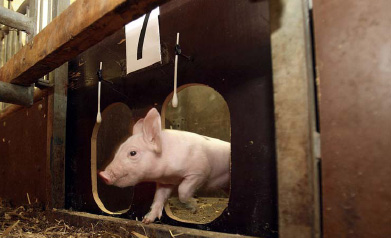
Day in and day out, many pig producers around the world breed their pigs, wean them and grow them to slaughter age. In order to do so, the animals need to receive sufficient amounts of feed from a young age onwards. But how do the pigs learn how and what to eat? Learn how to eat like a pig – and pigs will be better understood, concluded Dr Marije Oostindjer, WUR, in her PhD study.
Piglets in commercial husbandry are generally weaned between three and four weeks of age for economic reasons, which is earlier and more abrupt than would occur under (semi-)natural conditions. Many piglets have no experience with solid food before weaning, resulting in low food intake and growth after weaning. Newly weaned piglets often also show a high incidence of diarrhoea and maladaptive behaviours after weaning due to the low food intake and high stress levels at weaning and thus reduced health and welfare.
The aim of this research was to explore whether providing piglets with more opportunities to learn from their mother about what, how and where to eat can increase food intake before and after weaning and consequently can reduce health and welfare problems after weaning. Young animals learn from experienced conspecifics what, where and how to eat. This social learning may also be important for piglets and when given the opportunity, piglets would follow the sow while she is searching for food and eating. In pig husbandry, however, the opportunities to learn from the sow are very limited as the sow is often confined throughout lactation, fed a different feed than the piglets in an inaccessible, raised trough. Sows and piglets are also mostly housed in rather barren, stimulus-poor pens. Three pathways of learning that could probably be improved in current pig husbandry have been chosen for review:• Direct learning from the sow through cues derived from observation and eating together
• Learning in an enriched environment and
• Learning from flavour cues in the maternal diet
Direct learning from the sow
Providing piglets with more opportunities to directly learn from the sow may stimulate the development of feeding related and social behaviours, which may result in a higher food intake before weaning and consequently result in a higher food intake after weaning. Providing piglets and sow with an enriched environment may increase the amount of information that piglets can acquire from the sow because the sow can show more behaviours.
Enrichment
Enrichment may also provide piglets with the opportunity to practise behaviours, and enrichment in early in life may increase the ability to adapt to stressful situations, such as being weaned abruptly. An experiment investigated effects of increased opportunities to directly learn from the sow and an enriched environment. Piglets were reared with a confined or loose-housed sow in a barren or in an enriched (straw, wood shavings, peat and branches) environment. Piglets could eat together with the sow in a family feeder if the sow was loose-housed. After weaning half of each litter was housed in a barren pen and half in an enriched pen.
The barren and enriched housed piglets from the loose-housed sows were exposed to a novel food test either with their mother present or absent. Being able to eat novel foods together with the mother resulted in a lower reluctance to approach and eat the novel food and a higher intake. Piglets from an enriched environment were already less reluctant to eat the novel food, regardless of whether their mother was present or not, and also had a higher food intake. Being able to eat together with the sow and being reared in an enriched environment also had positive effects on feeding-related behaviours and growth in the home pen. Enrichment of the lactation pen also had positive effects on postweaning food intake, indicating that preweaning enrichment can help to stimulate early food intake in piglets. Being reared with a loose-housed sow had positive effects on behaviour postweaning, suggesting that the sow is important in the development of adaptive behaviour. Postweaning enrichment had profound positive effects after weaning: a higher growth in the two weeks after weaning, a profoundly lower diarrhoea prevalence and a higher feed efficiency. Piglets also showed more play and less damaging behaviours postweaning when housed in an enriched pen.
These positive effects of enrichment may be due to decreased stress levels or increased gut health. Preweaning and postweaning enrichment did interact with each other: piglets from an enriched lactation pen housed in a barren pen postweaning showed a lower performance, more damaging behaviour and low levels of play in the first two weeks postweaning, so if enrichment is provided before weaning it is important to also provide it after weaning. Enrichment of the pre- and postweaning environment, and being able to eat together with the sow thus seems important in improving performance, health and welfare of newly weaned pigs.There are many learning processes involved in eating together: observing what the mother does, participating, learning about the location of the food and learning about the type of food that the mother eats. Learning from the sow is more effective than exposing piglets to the food without being able to learn from the sow. Observing or participating with the sow while she is eating were both effective in stimulating piglet food intake and in establishing a preference for the food eaten by the sow. Piglets use information about the location where the food was present, but prioritise information about the type of food that the sow eats. This indicates that it is important to let sow and piglets
eat together, but particularly to provide sow and piglets with the same food.
Flavour cues
The results from the experiments on flavour learning further stress the importance of matching sow and piglet food, at least in flavour. Young animals can learn from flavours in the maternal diet, which enhances recognition, preference and acceptance of foods containing these flavours around weaning. In a first experiment piglets were exposed to anise flavour through the maternal diet before birth, during lactation, both, or never, before weaning. Piglets that were exposed to the flavour before birth recognised the flavour after birth in several behavioural tests, also see box ‘The Gate Preference Test’.
The clearest effects on behaviour were found in tests eliciting a moderate stress response, suggesting that the mere presence of a familiar flavour may reduce stress. Piglets were provided with control food and flavoured food after weaning, and piglets that were exposed to the flavour through the maternal diet did not show a preference for the flavoured food. Prenatally exposed piglets did, however, show a higher food intake, less diarrhoea and less damaging behaviours.
In the research, various criteria were used to prove this relationship – e.g. the effect was measured on latency to eat, play behaviour, manipulating and vocalisations. Good results were noted when a similar flavour from preweaning was around – e.g. when it was in the air. There, considerably fewer piglets lost weight in the first three days post-weaning.
The lack of preference for the flavour, together with the results from the preweaning behavioural tests suggest that the effects were due to reduced stress at weaning, caused by the presence of the familiar flavour. Piglets exposed to anise flavour through the maternal diet both before and after birth, or never, were provided with the anise flavour in the air or in the food after weaning. Piglets exposed to the flavour showed lower levels of cortisol after weaning, less variation in growth, less damaging behaviours, more play behaviour and less vocalisations, all indicative of reduced stress. It did not matter whether the flavour was present in the food or only in the air, suggesting it is particularly the odour of the familiar flavour that is important in reducing weaning stress.
Information
In conclusion, information from the sow plays a critical role in the development of independent feeding and reducing weaning-related problems. Currently, piglets do not have enough opportunities to learn from the sow, and lactation pens and food of sows and piglets could be improved to create possibilities for sow and piglets to eat together and to eat the same food during lactation.
Enrichment may be provided both before and after weaning to further stimulate the development of solid food intake. Reducing stress through enrichment and providing a flavour associated with the sow’s diet will further ensure an improved performance, health and welfare of newly weaned piglets.
The Gate Preference Test Many trials were carried out to find out more about piglet behaviour. One of the trials Oostindjer and her team conducted was a so-called ‘Gate Preference Test’, carried out with piglets of about six or seven days old. They were separated from the sow and given the opportunity to return to the sow via either an anise-scented gate or a mint-scented gate, created by placing anise-and mint-flavoured swabs. The piglets were given five minutes to find their way back – and all behaviour was monitored, e.g. sniffing, chewing, choosing the gate, starting position. It was expected piglets would have a preference for a familiar smelling gate to move from a nonsafe environment to a safe environment (with the sow). Results seemed to confirm this: When the anise was placed above the right gate, piglets exposed to anise prenatally tended to show a higher interest (i.e. sniffing and chewing) in the anise gate, and showed a lower interest in the control gate than control piglets. Piglets that were prenatally exposed to anise spent more time on the anise side of the test than control piglets, who spent more time on the control side of the arena when anise was above the right gate. |
Join 18,000+ subscribers
Subscribe to our newsletter to stay updated about all the need-to-know content in the pigsector, three times a week. Beheer
Beheer

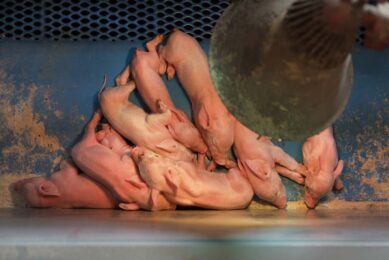
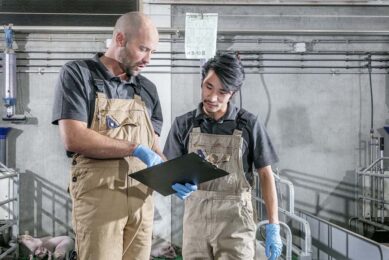
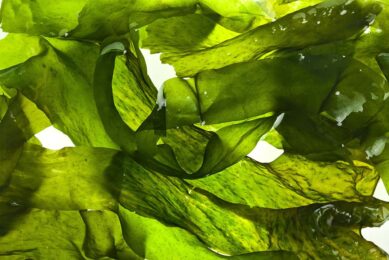
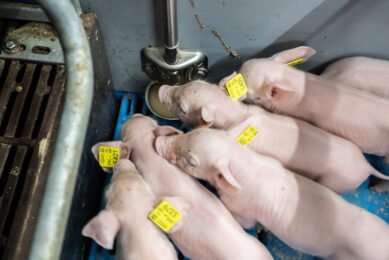





 WP Admin
WP Admin  Bewerk bericht
Bewerk bericht